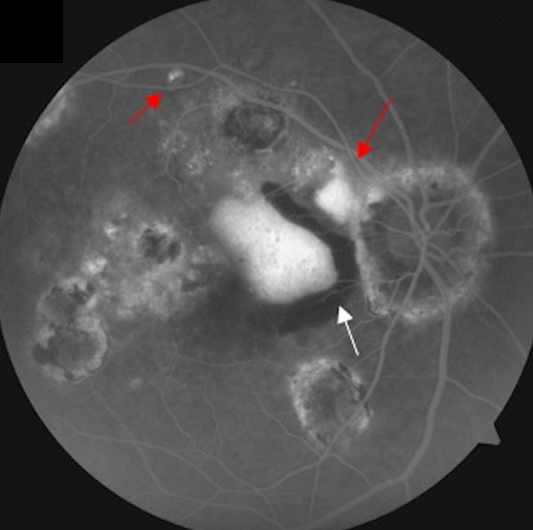Polypoidal choroidal vasculopathy 20 years after resolution of tubercular choroiditis
Main Article Content
Abstract
We report the case of a 72-year-old white woman with blurring of vision in both eyes of 15 days’ duration. She had a history of treatment for bilateral tuberculosis choroiditis 20 years before. She was diagnosed with polypoidal choroidal vasculopathy in the right eye and inflammatory choroidal neovascular membrane in the left eye, based on multimodal imaging, including optical coherence tomography, fundus fluorescein angiography, and indocyanine green angiography. The right eye received 3 intravitreal injections of aflibercept and showed complete resolution. The left eye was treated with a single intravitreal injection of aflibercept.
Downloads
Article Details

This work is licensed under a Creative Commons Attribution-NonCommercial-NoDerivatives 4.0 International License.
References
Karti O, Ipek SC, Ates Y, Saatci AO. Inflammatory choroidal neovascular membranes in patients with noninfectious uveitis: the place of intravitreal anti-VEGF therapy. Med Hypothesis Discov Innov Ophthalmol 2020;9:118-26.
Karti O, Saatci AO. Optical coherence tomography angiography in eyes with non-infectious posterior uveitis; some practical aspects. Med Hypothesis Discov Innov Ophthalmol 2019;8:312-22.
Parodi MB, Iacono P, La Spina C, Knutsson KA, Mansour A, Arevalo JF, Bandello F. Intravitreal bevacizumab for choroidal neovascularisation in serpiginous choroiditis. Br J Ophthalmol 2014;98:519-22. DOI: https://doi.org/10.1136/bjophthalmol-2013-304237
Perente A, Kotsiliti D, Taliantzis S, et al. Serpiginous choroiditis complicated with choroidal neovascular membrane detected using optical coherence tomography angiography: a case series and literature review. Turk J Ophthalmol 2021;26;51:326-33. DOI: https://doi.org/10.4274/tjo.galenos.2021.49323
Yannuzzi LA, Sorenson J, Spaide RF, Lipson B. Idiopathic polypoidal choroidal vasculopathy (IPCV). Retina 1990;10:1-8. DOI: https://doi.org/10.1097/00006982-199001010-00001
Yannuzzi LA, Ciardella A, Spaide RF, Rabb M, Freund KB, Orlock DA. The expanding clinical spectrum of idiopathic polypoidal choroidal vasculopathy. Arch Ophthalmol 1997;115:478-85. DOI: https://doi.org/10.1001/archopht.1997.01100150480005
Kim D, Ryu G, Sagong M. Polypoidal choroidal vasculopathy as a complication of choroidal osteoma: a case report. Medicine (Baltimore) 2020;99:e19927. DOI: https://doi.org/10.1097/MD.0000000000019927
Fine HF, Ferrara DC, Ho I-V, et al. Bilateral choroidal osteomas with polypoidal choroidal vasculopathy. Retin Cases Brief Rep 2008;2:15-7. DOI: https://doi.org/10.1097/ICB.0b013e318159e7e9
Shields CL, Shields JA, Augsburger JJ. Choroidal osteoma. Surv Ophthalmol 1988;33:17-27. DOI: https://doi.org/10.1016/0039-6257(88)90069-0
Palkar AH, Khetan V. Polypoidal choroidal vasculopathy: an update on current management and review of the literature. Taiwan J Ophthalmol 2019;9:72-92. DOI: https://doi.org/10.4103/tjo.tjo_35_18




